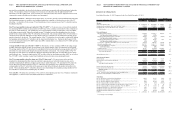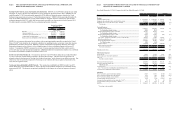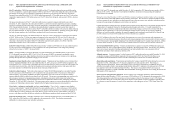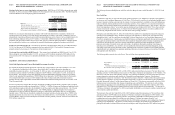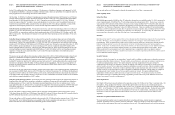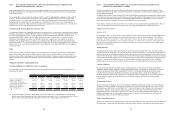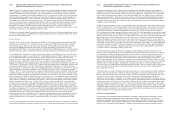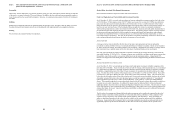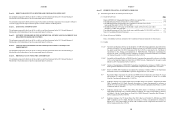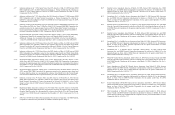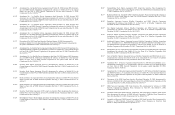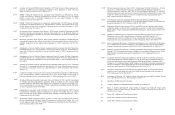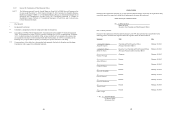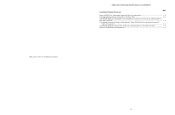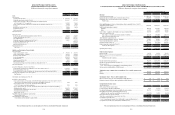Dish Network 2012 Annual Report Download - page 47
Download and view the complete annual report
Please find page 47 of the 2012 Dish Network annual report below. You can navigate through the pages in the report by either clicking on the pages listed below, or by using the keyword search tool below to find specific information within the annual report.Item 7. MANAGEMENT’S DISCUSSION AND ANALYSIS OF FINANCIAL CONDITION AND
RESULTS OF OPERATIONS - Continued
82
82
effects of revisions are reflected prospectively in the period they occur. The following represent what we believe are
the critical accounting policies that may involve a high degree of estimation, judgment and complexity. For a summary
of our significant accounting policies, including those discussed below, see Note 2 in the Notes to our Consolidated
Financial Statements in Item 15 of this Annual Report on Form 10-K.
x Capitalized satellite receivers. Since we retain ownership of certain equipment provided pursuant to our
subscriber equipment lease programs, we capitalize and depreciate equipment costs that would otherwise be
expensed at the time of sale. Such capitalized costs are depreciated over the estimated useful life of the
equipment, which is based on, among other things, management’s judgment of the risk of technological
obsolescence. Because of the inherent difficulty of making this estimate, the estimated useful life of
capitalized equipment may change based on, among other things, historical experience and changes in
technology as well as our response to competitive conditions. Changes in estimated useful life may impact
“Depreciation and amortization” on our Consolidated Statements of Operations and Comprehensive Income
(Loss). For example, if we had decreased the estimated useful life of our capitalized subscriber equipment by
one year, annual 2012 depreciation expense would have increased by approximately $84 million.
x Accounting for investments in private and publicly-traded securities. We hold debt and equity interests in
companies, some of which are publicly traded and have highly volatile prices. We record an investment
impairment charge in “Other, net” within “Other Income (Expense)” on our Consolidated Statements of
Operations and Comprehensive Income (Loss) when we believe an investment has experienced a decline in
value that is judged to be other-than-temporary. We monitor our investments for impairment by considering
current factors including economic environment, market conditions and the operational performance and other
specific factors relating to the business underlying the investment. Future adverse changes in these factors
could result in losses or an inability to recover the carrying value of the investments that may not be reflected
in an investment’s current carrying value, thereby possibly requiring an impairment charge in the future.
x Fair value of financial instruments. Fair value estimates of our financial instruments are made at a point
in time, based on relevant market data as well as the best information available about the financial
instrument. Sustained economic weakness has resulted in inactive markets for certain of our financial
instruments, including our Auction Rate Securities (“ARS”) and other investment securities. For certain of
these instruments, there is no or limited observable market data. Fair value estimates for financial
instruments for which no or limited observable market data is available are based on judgments regarding
current economic conditions, liquidity discounts, currency, credit and interest rate risks, loss experience and
other factors. These estimates involve significant uncertainties and judgments and may be a less precise
measurement of fair value as compared to financial instruments where observable market data is available.
We make certain assumptions related to expected maturity date, credit and interest rate risk based upon
market conditions and prior experience. As a result, such calculated fair value estimates may not be
realizable in a current sale or immediate settlement of the instrument. In addition, changes in the
underlying assumptions used in the fair value measurement technique, including liquidity risks, and
estimate of future cash flows, could significantly affect these fair value estimates, which could have a
material adverse impact on our financial position and results of operations. For example, as of December
31, 2012, we held $106 million of securities that lack observable market quotes, and a 10% decrease in our
estimated fair value of these securities would result in a decrease of the reported amount by approximately
$11 million.
x Valuation of long-lived assets. We evaluate the carrying value of long-lived assets to be held and used, other
than goodwill and intangible assets with indefinite lives, when events and circumstances warrant such a
review. We evaluate our DBS satellite fleet for recoverability as one asset group. See Note 2 in the Notes to
our Consolidated Financial Statements in Item 15 of this Annual Report on Form 10-K. The carrying value of
a long-lived asset or asset group is considered impaired when the anticipated undiscounted cash flows from
such asset or asset group is less than its carrying value. In that event, a loss will be recorded in a new line
item entitled “Impairments of indefinite-lived and long-lived assets” on our Consolidated Statements of
Operations and Comprehensive Income (Loss) based on the amount by which the carrying value exceeds the
fair value of the long-lived asset or asset group. Fair value is determined primarily using the estimated cash
flows associated with the asset or asset group under review, discounted at a rate commensurate with the risk
involved. Losses on long-lived assets to be disposed of by sale are determined in a similar manner, except
Item 7. MANAGEMENT’S DISCUSSION AND ANALYSIS OF FINANCIAL CONDITION AND
RESULTS OF OPERATIONS - Continued
83
83
that fair values are reduced for estimated selling costs. Among other reasons, changes in estimates of future
cash flows could result in a write-down of the asset in a future period.
x Valuation of intangible assets with indefinite lives. We evaluate the carrying value of intangible assets with
indefinite lives annually, and also when events and circumstances warrant. We use estimates of fair value to
determine the amount of impairment, if any, of recorded intangible assets with indefinite lives. Fair value is
determined using the estimated future cash flows, discounted at a rate commensurate with the risk involved or
the market approach. While our impairment tests in 2012 indicated the fair value of our intangible assets
exceeded their carrying amounts, significant changes in our estimates of future cash flows or market data
could result in a write-down of intangible assets with indefinite lives in a future period, which will be recorded
in a new line item entitled “Impairments of indefinite-lived and long-lived assets,” on our Consolidated
Statements of Operations and Comprehensive Income (Loss) and could be material to our consolidated results
of operations and financial position. Based on the methodology utilized to test for impairment a 10% decrease
in the estimated future cash flows or market value of comparable assets and/or, a 10% increase in the discount
rate used in estimating the fair value of these assets (while all other assumptions remain unchanged) would not
result in these assets being impaired.
x Income taxes. Our income tax policy is to record the estimated future tax effects of temporary differences
between the tax bases of assets and liabilities and amounts reported in the accompanying consolidated balance
sheets, as well as operating loss and tax credit carryforwards. Determining necessary valuation allowances
requires us to make assessments about the timing of future events, including the probability of expected future
taxable income and available tax planning opportunities. We periodically evaluate our need for a valuation
allowance based on both historical evidence, including trends, and future expectations in each reporting
period. Any such valuation allowance is recorded in either “Income tax (provision) benefit, net” on our
Consolidated Statements of Operations and Comprehensive Income (Loss) or “Accumulated other
comprehensive income (loss)” within “Stockholders’ equity (deficit)” on our Consolidated Balance Sheets.
Future performance could have a significant effect on the realization of tax benefits, or reversals of valuation
allowances, as reported in our consolidated results of operations.
x Uncertainty in tax positions. Management evaluates the recognition and measurement of uncertain tax
positions based on applicable tax law, regulations, case law, administrative rulings and pronouncements and
the facts and circumstances surrounding the tax position. Changes in our estimates related to the recognition
and measurement of the amount recorded for uncertain tax positions could result in significant changes in our
“Income tax provision (benefit), net,” which could be material to our consolidated results of operations.
x Contingent liabilities. A significant amount of management judgment is required in determining when, or if,
an accrual should be recorded for a contingency and the amount of such accrual. Estimates generally are
developed in consultation with counsel and are based on an analysis of potential outcomes. Due to the
uncertainty of determining the likelihood of a future event occurring and the potential financial statement
impact of such an event, it is possible that upon further development or resolution of a contingent matter, a
charge could be recorded in a future period to “General and administrative expenses” or “Litigation expense”
on our Consolidated Statements of Operations and Comprehensive Income (Loss) that would be material to
our consolidated results of operations and financial position.
x Business combinations. When we acquire a business, we allocate the purchase price to the various
components of the acquisition based upon the fair value of each component using various valuation
techniques, including the market approach, income approach and/or cost approach. The accounting standard
for business combinations requires most identifiable assets, liabilities, noncontrolling interests and goodwill
acquired to be recorded at estimated fair value. Determining the fair value of assets acquired and liabilities
assumed requires management’s judgment and often involves the use of significant estimates and
assumptions, including assumptions with respect to the estimated future cash flows, discounted at a rate
commensurate with the risk involved or the market approach.



